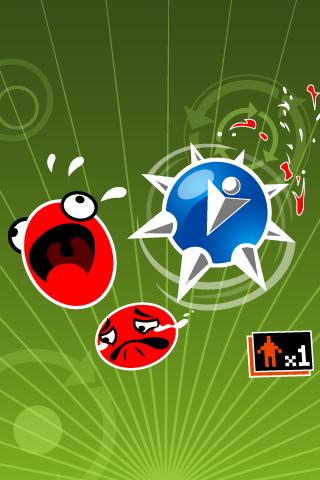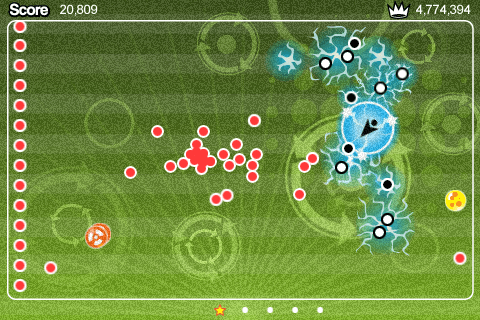- Wondering how to get Monopoly GO! free rolls? Well, you’ve come to the right place. In this guide, we provide you with a bunch of tips and tricks to get some free rolls for the hit new mobile game. We’ll …
Best Roblox Horror Games to Play Right Now – Updated Weekly
By Adele Wilson
Our Best Roblox Horror Games guide features the scariest and most creative experiences to play right now on the platform!The BEST Roblox Games of The Week – Games You Need To Play!
By Sho Roberts
Our feature shares our pick for the Best Roblox Games of the week! With our feature, we guarantee you'll find something new to play!Type Soul Clan Rarity Guide – All Legendary And Common Clans Listed!
By Nathan Ball
Wondering what your odds of rolling a particular Clan are? Wonder no more, with my handy Type Soul Clan Rarity guide.
Tilt to Live: a post mortem
The App Store and iPhone has changed a lot of once held beliefs since its release. Prior to the iPhone, to make it as an indie you had to work tirelessly and in obscurity for several years, building up your user base at a glacial pace. All at the same time struggling to maintain your name on your creations as you tried to distribute it to the biggest audiences while getting a minuscule piece of the pie. We were ready to embark on that adventure, but decided to give the iPhone market a try before committing to a larger project.

The App Store and iPhone has changed a lot of once held beliefs since its release. Prior to the iPhone, to make it as an indie you had to work tirelessly and in obscurity for several years, building up your user base at a glacial pace. All at the same time struggling to maintain your name on your creations as you tried to distribute it to the biggest audiences while getting a minuscule piece of the pie. We were ready to embark on that adventure, but decided to give the iPhone market a try before committing to a larger project. With the small form factor and less computing power than high end PC’s, we thought a smaller project quickly done on the iPhone would be a good start to get our feet wet in developing commercial games. Little did we know, it would become our pride and joy and also our main platform. It also changed our entire game plan. Tilt to Live catapulted us from part-time indies to launching a full-time business in indie game development in the span of a few short months rather than our original plan of several years.
In the following paragraphs I try to summarize our experience with conceptualizing, developing, marketing, and maintaining Tilt to Live over the course of the last year and a half. So many things went right as well as went wrong for us that I had a hard time picking them. I decided to pick ones that I deemed not necessarily the biggest items that went right or wrong, but the ones I felt were the most interesting or least talked about.
What Went Right
1. A small scope upon release
Set on the idea of making a simple, small scope, novel game, the accelerometer quickly become the center of our attention. We quickly had a prototype of Tilt to Live up and running on an iPhone within a couple days. Having friends and colleagues test it, it was clear we had a simple and fun game that people quickly understood how to play. At this point, the core game was done. No complex game rules, no complex UI, options, or alternative inputs. We introduced a few more weapon types, but it never complicated the user’s inputs. The weapons were just a fun and varied way to do the same thing: eliminate on the screen before they overwhelm you.

Above: Screenshot of the early prototype of Tilt to Live

Above: a more evolved screenshot of the Tilt to Live prototype
2. Off the cuff graphics and audio
With the game being an abstract shooter of sorts, we had a few decisions to make aesthetically. In an effort to stand out, we avoided the retro and neon look and feel of similar arcade games. The game’s designs and textures were minimalistic and vivid, but the real polish came from the fluid animations of the simple shapes and UI. Unfortunately screenshots didn’t do the game much justice, but once people saw the game in motion they tended to be pleasantly surprised at the polished feel due to us emphasizing more animations done with simple shapes.
On the audio side, we went in different directions as well. Most shooters tend to have a sci-fi or abstract twist to them so they tend to go with a techno or electronica type theme music. We thought giving Tilt to Live a more lively theme centered around swing and drums would help give it a more wide appeal. We feel we hit something special here because we’re constantly inundated with requests for a Tilt to Live soundtrack. For a game with such a limited scope, getting the musical style right was a big win for us.

3. Getting a community excited and enthusiastic about our game
One should never underestimate the power of a vocal community on the internet. Tilt to Live was no exception. Prior to launch we tried different marketing ideas to get the game out there, but the simplest and most transparent seemed to pay off more than any amount of advertising or PR we could ever afford. We became active inside the communities that are enthusiastic about iPhone games. By getting players interested in the game, word of mouth started early and we were talking directly to people genuinely interested in the game. Once the game hit the App Store, some of our biggest opportunities for exposure came directly from the Touch Arcade community of iPhone/iPod gamers. Being a new developer, having a group of gamers vouch for the quality of our game helped us get noticed by not only the editorial staff, but by several other media outlets who at first never really game us the time of day. For any developers working on debut projects, time invested in getting to know your potential audience and making sure to stay in touch with them regularly is probably the best and most vital course of action in launching a game.
4. Content updates kept the game in the limelight
This came to us as a bit of a surprise. Upon launch, after our major sales spikes settled out we assumed we’d be working on our next project within a month’s time. The App Store has changed user expectations about software in general in fundamental ways. Games in particular have an expectation to be updated with new content and features. We played around with the idea by releasing 2 more game modes in the coming months after launch. The result? Instead of our sales continuing their downward trend, they held steady. Coupled with a free promotion, our game’s new content was able to make it into the news cycle multiple times. While these subsequent events were never as big as our launch day, they helped keep our game afloat sales-wise regardless of the rank it had. We kind of adopted a ‘Valve’ philosophy and planned even more expansive updates to the game for free. It was more economical to add content to an already established and decently successful game, than start from scratch on a new project. Our fans loved it, and we liked to think they rewarded us by spreading the news by word of mouth. Even today, Tilt to Live is extremely low on the charts but the sales remainlargely independent of rank.
5. The proverbial Apple Feature
If you ask any iOS developer what they’d single out as one of their major contributing factors to the success of their game, many of them would answer “Apple”. The ease of distribution on the App Store has opened the flood gates, and users are overwhelmed with options. The “magical” Apple feature has changed the course of many developer’s careers. Getting featured in the App Store is almost like getting a foot inside the door of the games industry or any other highly competitive field. We had a few missteps while being featured (that I’ll cover in a minute), but it certainly helped us establish ourselves as a competent game development team that can produce a quality game, and Apple and others now knew this.
What Went Wrong
1. Estimating was all over the place, which hurt marketing schedules
Most people are pretty confident in their physical abilities and limitations. I, for one, am certain I cannot lift my car. When it comes to mental limitations, things tend to get more hazy. Project estimations tended to fall into that mental limitation trap. I could easily convince myself I could do some non-trivial feature in a pretty speedy time because I know the general path I need to take to get it done. When it comes to actually doing the work, I find there are a lot of missteps and miscalculations. Most of this is coming from inexperience as I’m writing for a new platform, OS, and device. But early on, and particularly during our content updates, I was constantly underestimating the time needed for the task. An added complication was that for most of the development of Tilt to Live we held full time day jobs. This wasn’t a problem prior to launch because we weren’t operating on any set deadline. But once we released, users were wanting to know what was coming next and when. The inability to estimate tasks correctly wreaked havoc on our marketing schedule. While we always took the path of delaying an update to get it right rather than releasing it undercooked, it did us no favors with our fans and hindered us when it came to trying to get more exposure in the media.

2. Too much aggressive price experimentation
When the Apple feature came along, we were super excited. Since Tilt to Live was our first serious foray into commercial game development, we wanted to experiment as much as possible with it. We played with prices a lot in the earlier days to see for ourselves the effect of price drops. We even went to the extent of making our game free for a week. While we learned a lot, it wasn’t without a cost. We alienated a portion of our user base who felt taken advantage of because they bought in at a higher price, only to see the price drop the next day, or worse, see it go free. Due to the structure of the App Store it’s impossible to not upset at least a small number of users whenever the price fluctuates, but going forward we intend to be far less volatile with our prices.
3. A long development time
Despite the simplicity of Tilt to Live, it took much longer than expected. A large part of this is attributed to the fact that we were working part-time for most of the development cycle. With only 1-2 hours a night to make progress on a game, sometimes it’s hard to inch forward when there is a lot of stop and go, as by the time I’m finally making decent progress it was usually time to wrap up and head to bed. As a result, a lot of weekends were spent catching up and getting some of the ‘bigger’ features done on Tilt to Live, like the UI animation systems, and some of the more intricate weapons. Meanwhile the weekdays ended up being more reserved for the smaller fixes and polish items that I can do within a single sitting. It was trying at times, but to think Tilt to Live was in development for at least a year is a bit surprising, considering the actual time spent totalled probably no more than 5 months of full time work.
4. Using prototype code (Longer development times with each new feature)
Iteration has always been a key to getting something “just right”. With that said, we iterated on the prototype until we had a final product. There was never an explicit ‘prototyping’ phase and a “production” phase. The dinky prototype we created a year ago grew into the current version of Tilt to Live we have today. It was also the first app I had written in Objective-C and for the iPhone. There was a huge learning process while developing the game so there were a lot of missteps coding-wise. Sometimes, just jumping in there and getting it done is much more important than spending time “getting it right”, when you may not even know “the right way” because you’re so new to the environment. The bad news is the game’s code base has become more brittle than we’d like. With each successive game mode or weapon, lots of compromises were made in the design of the game’s engine to get it up and running as quickly as possible. With each new game mode, the development time becomes longer and longer not because the features are more complex, but the code rot that is happening is creating a lot of unforeseen bugs springing up in the unlikeliest of places. I don’t think scrapping a working prototype and starting from square one for a production ready project is the best route either. There has to be a balance of technology re-use in the prototype and assessing whether the architecture of the project is sufficiently easy to expand upon in the future.

5. Not getting a lite version out earlier
The decision to not make a lite version was a conscious one at first. At launch, Tilt to Live sported one game mode and 8 weapons. Doing a lite version of that didn’t make sense to us. As Tilt to Live expanded and included more weapons and modes, a lite version would have made much more sense in getting the word out. But we were so caught up in content updates we never came back to assess the practicality of a lite version until very recently. Tilt to Live HD, our iPad adaptation of the game, showed the power of “free” as a good marketing tool, and we’d be amiss to not take advantage of that in the future.
Wrapping Up
It’s fun to think that at one point we didn’t even own a Mac, much less knew how to code in XCode or Objective-C, and now we’re running a business exclusively on iOS and Macs. We’ve learned a ton developing Tilt to Live and it’s gotten us pretty excited about what we can do for future projects. The basics of running a business out of the App Store and developing games targeting such a market are constantly evolving. There was a time when in-app purchases didn’t exist, and now whole games are basing their entire business model off of it. With the numerous hard lessons learned developing Tilt to Live, I think we’ll be in decent shape to adapt to whatever the market throws at us next.
More articles...
Monopoly GO! Free Rolls – Links For Free Dice
By Glen Fox
Wondering how to get Monopoly GO! free rolls? Well, you’ve come to the right place. In this guide, we provide you with a bunch of tips and tricks to get some free rolls for the hit new mobile game. We’ll …Best Roblox Horror Games to Play Right Now – Updated Weekly
By Adele Wilson
Our Best Roblox Horror Games guide features the scariest and most creative experiences to play right now on the platform!The BEST Roblox Games of The Week – Games You Need To Play!
By Sho Roberts
Our feature shares our pick for the Best Roblox Games of the week! With our feature, we guarantee you'll find something new to play!Type Soul Clan Rarity Guide – All Legendary And Common Clans Listed!
By Nathan Ball
Wondering what your odds of rolling a particular Clan are? Wonder no more, with my handy Type Soul Clan Rarity guide.







